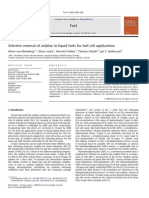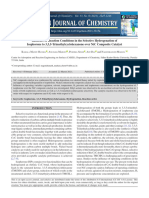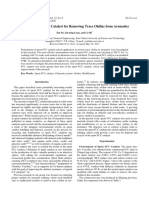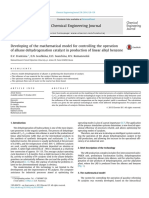Investigation of Kinetics of Hydroisomerization of C /C and C /C Alkanes and Their Binary Mixtures
Investigation of Kinetics of Hydroisomerization of C /C and C /C Alkanes and Their Binary Mixtures
Uploaded by
Omar SaeedCopyright:
Available Formats
Investigation of Kinetics of Hydroisomerization of C /C and C /C Alkanes and Their Binary Mixtures
Investigation of Kinetics of Hydroisomerization of C /C and C /C Alkanes and Their Binary Mixtures
Uploaded by
Omar SaeedOriginal Title
Copyright
Available Formats
Share this document
Did you find this document useful?
Is this content inappropriate?
Copyright:
Available Formats
Investigation of Kinetics of Hydroisomerization of C /C and C /C Alkanes and Their Binary Mixtures
Investigation of Kinetics of Hydroisomerization of C /C and C /C Alkanes and Their Binary Mixtures
Uploaded by
Omar SaeedCopyright:
Available Formats
HUNGARIAN JOURNAL
OF INDUSTRIAL CHEMISTRY
VESZPRÉM
Vol. 39(1) pp. 117-120 (2011)
INVESTIGATION OF KINETICS OF HYDROISOMERIZATION OF
C5/C6 AND C6/C7 ALKANES AND THEIR BINARY MIXTURES
ZS. SZOBOSZLAI , J. HANCSÓK
University of Pannonia, Department of MOL Hydrocarbon and Coal Processing
8200, Veszprém Egyetem u. 10, HUNGARY
E-mail: szzsolt@almos.uni-pannon.hu
Modern gasoline quality requirements globally became stricter. These specifications parallel with the applied developments
of vehicle technologies contributing to the cleaner environment. Nowadays only the concentration of cyclo- and isoparaffins
are not limited in gasoline, because they burn cleaner, have high octane number, lower sensibility and better combustion
properties than aromatic or olefinic hydrocarbons. In the last decade because of the applied refinery investments both sulfur
and aromatic content of gasolines decreased, but the octane mass of the gasoline pool significantly decreased against the
increment of octane number requirement of spark ignition engines. Importance of isomerization of light paraffins has
been publicized in many papers. However few of them investigated, studied and explained the individual hydrocarbons
(C5/C6/C7) interaction with each other in multicomponent mixtures practically in similar to industrial hydrocarbon
feedstocks. Binary and multicomponent hydrocarbon mixture investigations can contribute to the understanding the results of
isomerization of real, feedstocks from multiple sources; which contain higher boiling point hydrocarbons (cycloparaffins,
benzene, and heptanes). Further these results can help to operate with higher flexibility, safety and economically a light
naphtha isomerization units. The hydroisomerization of n-pentane (n-C5), n-hexane (n-C6), cyclohexane (c-C6) and n-heptane
(n-C7) and their binary mixture were studied on Pt/sulfated zirconia catalyst at temperature 150–170 °C, total pressure
20 bar, 1:1 H2-hydrocarbon molar ratio. The apparent activation energies of all individual components, further the reaction
rates individually and in different composition binary mixtures were specified. Results of our experiments concluded that
the rate of reaction of the higher carbon number hydrocarbon or in case of the same carbon number the cycloparaffins (lower
volatility component) increased with increasing the concentration in the binary mixtures, while the rate of reaction of higher
volatility component decreasing.
Keywords: Isomerization, light naphtha
Introduction
Nowadays the fractions rich in isoparaffin are the most
important blending components of the gasolines because
they have high octane number, low sensibility, they are
practically free from sulphur, olefin, and aromatics, they
have low toxicity, and undesired molecules are not
generated under controlled combustion [1-4]. The
continuous demands for the application of isoparaffin
rich hydrocarbon fractions are the followings:
From 2000
– Low benzene and decreased aromatic concentration
(research octane number and octane number distribution) Figure 1: Constructed refinery investments in the EU
– Reducing the research octane number give away for high quality gasoline production until 2005
– Supplementation of the octane number decrease of the to fulfill the 2005 gasoline regulations
deep desulphurization of cracked naphthas
– Regulation of the application of MTBE The simultaneous reduction of the sulphur and
– Balancing the boiling range shifting in case of heavier aromatic content significantly decreased the octane number
ether (ETBE, TAME) application in high concentration of the gasoline pool against the increasing octane number
From 2005 requirements of the Otto engines (higher compression
– Further deep desulphurization ratio → higher octane number → higher volumetric
– Further reduced aromatic and benzene content efficiency and specific power with lower emission).
118
The importance of isoparaffin rich fractions is Experimental eqipment
presented in Fig. 1 which shows what the most important
investments are in the refineries to satisfy the demands
The applied catalytic system contains a 100 cm3 vertical
and meet the new specifications [1-4]. It can be clearly
reactor and every instrument which can be found in a
seen that the highest investments in the refinery were
commercial scale light naphtha isomerization unit.
the light paraffin isomerization processes (though the
The catalytic system contains a gas regulator/control
application of light paraffins was slightly reduced by the
and pretreatment system and an on-line gas chromatograph.
bioethanol blending, in spite of the significant effect of
the ethanol on the gasoline physical-chemical application
properties the etherification and alkylation capacity can
Materials
be significantly increased by taking advance of the
isomerization capacity), but the alkylation unit installation
and revamping was also important. The possible ways We applied 60cm3 of in situ dried and activated
to produce industrial economically isoparaffin rich Pt/sulphated-zirconia (extrudated, D: 1.5mm) catalyst and
fractions are the following: the empty space was filled with Raschig rings.
● The proper naphtha fraction separation to iso- and The feedstocks were analytical grade, sulphur free n-
normal paraffin fractions pentane, n-hexane, cyclohexane and n-heptane. The
● Alkylation of isobutane with C3-C5 olefins (direct concentration of components was varied between 0–100%
alkylation) (0, 25, 50, 75 and 100% theoretically) in binary mixtures.
● Dimerization of C3-C5 fractions rich in olefins The practically sulfur free hydrocarbons continuous
(indirect alkylation) after hydrogenation demoisturising was done with Linde 4A molecule sieve.
● Isomerization of C5-C7 fractions rich in n-paraffins
o Isomerization of benzene containing fractions
Two-steps → two reactors and different Catalyst and test methods
catalysts
One step The applied catalyst was Pt/sulfated-zirconia. Main
• isomerization of benzene containing properties of the catalyst were shown by Table 1.
fractions (the saturation of benzene and
isomerization of the n-paraffins is done in Table 1: The main characteristics of applied catalysts
the same reactor and on the catalyst) [5-6]
• in the same reactor with segmented beds Properties Values
with different catalysts [4] Pt-content, % 0.415
Pt-dispersion, % 69
The specifications of the benzene concentration of Acidity, mmolNH3/g 0.56
the naphtha fraction can be ensured by adequate pre- and Sametalic (metal (Pt) surface on the catalyst),
25.91
post-treating so the feed of reformation does not contain m2/g metal
2
benzene precursor or after the reformation they have to Smetal (specific metal surface), m metal/g cat. 0.108
be fractionated (if the reformation is gasoline purpose) APS (average particle size of the metal), nm 2.0
from the product and saturated in the isomerization plant. Specific acidity, mmolNH3/m2 cat. 0.0043
The feedstock of both of the etherification and BET surface, m2/g 130
alkylation technologies are the C4-C5 isoparaffins Microporous surface, m2/g 12.2
consequently the light paraffin isomerization will be Microporous volume, cm3/g 0.0045
one of the key processes just partly producing internal Mezoporous volume, cm3/g 0.2874
components/feeds for other technologies. Mezo-/microporous volume ratio 63.9
Average pore size, nm(Å) 8.5(85)
Experimental
Standard measurements methods were used. Pt content
of the catalyst was measured by UOP-274 standard.
Aim of our experimental work was the investigation of BET surface area and total acidity of the catalyst was
isomerization of hydrocarbons with different volatility measured by NH3 sorption according to ASTM D3663 and
and their binary mixtures. We investigated that the D4824 standards, while pore size distribution and pore
isomerization effects/rate on each other further how volume was measured by mercury intrusion porosimetry
influenced the individual hydrocarbon the other in method according to ASTM D4284 and D6761 standards
laboratory scale reactor on steady state activity catalyst. respectively. The feeds and products composition was
The inspiration of this research work was the absent of measured with gas chromatograph according to ASTM-
large scale, long term catalytic studies with near D5134 standard.
industrially parameters [7-14]. The sulphur content of all feeds and products
(GREENLAB Ltd./Analytik-Jena - Multi EA 3100-type
device) with EN ISO 20846 (2003), water content
(GREENLAB Ltd./KEM - MKA-610-type device) with
ISO 12937:2001 standard was determined.
119
Process parameters becomes higher and near the equilibrium concentration
(cyclohexane↔methylcyclopentane) the cracking reaction
come to front that ascribe to methylcyclopentane. In the
Experiments were measured on steady state activity
examination of the gas phase composition it was
catalyst. Based on preliminary results the experiments
observed that the C2/C4 molar ratio was very low so the
was taken on 20 bar total pressure, 1.0–4.0 LHSVs,
isomerization and cracking reaction probably to take
H2/HC molar ratio was 1.0:1.0. Fine changes of the
place through C12-C8 intermediate products.
parameter combination kept measuring where the low
conversion rates (5–15%) of the individual hydrocarbon
were not inhibited by the products. 20
Reaction rate, 10-8 mol/s.gcat.
reaction rate of n-hexane
Results and discussion 15 reaction rate of n-pentane
Near low conversion rates the individual hydrocarbons 10
initial reaction rates were measured then the logarithmized
values were presented versus the inverse of temperature. 5
These methods were applied to determine the apparent
activation energies of hydrocarbons. Based on the given
data they had relatively high deviation, and these values 0
can be given with relatively high inaccuracy. Our values 0 20 40 60 80 100
and the publicized values are relevated well (Table 2) but n-pentane concentration in binary mixture, %
the most of them were determined in different catalytic
Figure 2: Changes in reaction rate of individual
system and with different parameter combinations [11-15].
components in the binary mixture
For example in case of the cyclohexane the measured
(T: 150 °C, LHSV: 1.5 h-1, P: 20 bar)
values are well correlated with publicized data
(100–150 kJ/mol).
35
Table 2: The apparent activation energies of individual
Reaction rate, 10-8 mol/s.gcat.
30
hydrocarbons reaction rate of n‐heptane
25
reaction rate of n‐hexane
Hydrocarbon n-pentane n-hexane n-heptane cyclo- 20
hexane
15
Eapparent, 10
measured 130–170 99–107 149–163 113–146
5
values, kJ/mol
0
Eapparent,
0 20 40 60 80 100
publicized 145–153 120 109–135 100–150
n-heptane concentration in binary mixture, %
values, kJ/mol
Figure 3: Changes in reaction rate of individual
The targeted quantity was added to n-hexane and components in the binary mixture
above 20% concentration it caused significantly lower (T: 150 °C, LHSV: 1.5 h-1, P: 20 bar)
reaction rate. So the reaction rate of the main
component decreased causing lower effectiveness under
80
isomerization consequently the adequate composition of
Reaction rate, 10-8mol/s.gcat.
the feed(s) has to be kept assured! 70
reaction rate of cyclohexane
Based on our measurement the reactivity of 60
reaction rate of n‐hexane
the individual hydrocarbons were the following: 50
c-C6>n-C7>n-C6>n-C5, the main cause was that the 40
adsorption energies of cycloparaffins is higher than the 30
same carbon number linear paraffins on strongly acidic 20
catalysts so in their mixtures increasing the individual 10
component reaction rate change with different degree 0
with the concentration interdependently (Fig. 2-4). In the 0 20 40 60 80 100
hexane the other component concentration more than cyclohexane concentration in binary mixture, %
20–30% the n-hexane reaction rate was approximately
halved and its component reaction rate was Figure 4.: Changes in reaction rate of individual
comparable/similar to the other individual component components in the binary mixture
reaction rate. In case of cycloparaffin isomerization the (T: 150 °C, LHSV: 1.5 h-1, P: 20bar)
lower H2 pressure was beneficial though it increased the
selectivity of ring opening reaction. On stricter parameter
combinations the ring isomerization selectivity
120
Conclusions 6. ZS. SZOBOSZLAI, J. HANCSÓK, SZ. MAGYAR:
Upgrading of Benzene Containing Hexane Feeds by
Simultaneous Isomerization at Low Temperature and
The individual component reaction rates were lower in
Saturation of Benzene, 6th International Colloquium,
every case than in their binary mixtures. The reaction
Fuels 2007, Germany, Esslingen, 2007, In Proceedings
rates were significantly decreased in the mixtures with
(ISBN 3-924813-67-1), 293–302
increasing the concentration of individual paraffin
hydrocarbons. 7. G. D. YADAV, J. J. NAIR: Sulfated zirconia and its
Based on the measured and calculated values it was modified versions as promising catalysts for industrial
concluded that in case of the non-adequate feed or in processes, Microporous and Mesoporous Materials
case of non-adapted isomerization catalyst – where 33, (1999), 1–48
accordingly to the demands the changes of process 8. J. M. SERRA, A. CHICA, A. CORMA: Development of a
parameters have not indicated any opportunity – influence low temperature light paraffin isomerization catalysts
of some component on the isomerization efficiency with improved resistance to water and sulphur by
become significant degree hereby the main linear chain combinatorial methods, Applied Catalysis A: General,
components with low octane number reactions rate of 239(1-2), (2003), 35–42
isomerization was interfered. 9. W. TAKEMI, M. HIROMI: Reaction of linear,
branched, and cyclic alkanes catalyzed by Brönsted
ACKNOWLEDGMENT and Lewis acids on H-mordenite, H-beta, and
sulfated zirconia. Journal of Molecular Catalysis A.
We acknowledge the financial support of this work by 239, (2005), 32–40
the Hungarian State and the European Union under the
10. J. C. DUCHET, D. GUILLAUME, A. MONNIER, C.
TAMOP-4.2.1/B-09/1/KONV-2010-0003 project.
DUJARDIN, J. P. GILSON, J. VAN GESTEL, G. SZABO,
P. NASCIMENTO: Isomerization of n-Hexane over
REFERENCES Sulfated Zirconia:Influence of Hydrogen and
Platinum, Journal of Catalysis 198, (2001), 328–337
1. U. SZALKOWSKA: Fuel quality - global overview,
7th international colloquium on fuels 2009, TAE, 11. A. HOLLÓ, J. HANCSÓK, D. KALLÓ: Kinetics of
Stuttgart/Ostfildern (Germany) hydroisomerization of C5-C7 alkanes and their
mixtures over platinum containing mordenite, Applied
2. H. WEYDA, E. KÖHLER: Modern refining concepts - Catalysis A: General, 229(1-2), (2002), 93–102
an update on naphtha-isomerization to modern
gasoline manufacture, Catalysis Today, 81(1), 12. T. LØFTEN, E. A. BLEKKAN: Isomerisation of n-
(2003), 51–55 hexane over sulphated zirconia modified by noble
metals, Applied Catalysis A: General 299, (2006),
3. SZ. MAGYAR, J. HANCSÓK, A. HOLLÓ: Key Factors 250–257
in the Production Of Modern Engine Gasolines, 6th
International Colloquim, Fuels 2007, Germany, 13. M. GUISNET, V. FOUCHE: Isomerization of n-hexane
Esslingen, 2007, In Proceedings (ISBN 3-924813- on platinum dealuminated mordenite catalysts, II.
67-1), 273–284 Kinetic Study, Appl. Catal, 71, (1991), 295–306
4. J. HANCSÓK, SZ. MAGYAR, ZS. SZOBOSZLAI, D. 14. H. LIU, G.D. LEI, W. M. H. SACHTLER: Alkane
KALLÓ: Investigation of energy and feedstock saving isomerization over solid acid catalysts. Effects of
production of gasoline blending components free of one-dimensional micropores, Appl. Catal., 137(1),
benzene, Fuel Processing Technology, 88(4), (2008), (1996), 167–177
393–399 15. C.-L. LI, L. SHI, G-X. HUANG, R.-Y. WANG: Scale-
5. J. HANCSÓK, SZ. MAGYAR, K. V. S. NGUYEN, ZS. up for Alkane Isomerization, Chem. Eng. Comm.,
SZOBOSZLAI, D. KALLÓ, A. HOLLÓ, GY. SZAUER: 121, (1993), 1–8
Simultaneous desulphurization, isomerization and
benzene saturation of n-hexane fraction on Pt-
H/MOR, Studies in Surface Science and Catalysis
(ISBN 0 444 52083 X), - Porous Materials in
Environmentally Friendly Processes 158, (2005),
1717–1724
You might also like
- Activation EnergyDocument9 pagesActivation Energyشكير قصطيNo ratings yet
- Physical Science: Quarter 1 - Module 3Document32 pagesPhysical Science: Quarter 1 - Module 3Jerome Manaig Suelto83% (12)
- FORZA Oxidation IHT Copy. - CompressedDocument1 pageFORZA Oxidation IHT Copy. - CompressedOmar SaeedNo ratings yet
- Formal Lesson Plan - EquilibriumDocument4 pagesFormal Lesson Plan - Equilibriumapi-300746864No ratings yet
- 2013 - JIEC - Octane Number Enhancement Studies Over Noble Metal Loaded Zeolite CatalystDocument6 pages2013 - JIEC - Octane Number Enhancement Studies Over Noble Metal Loaded Zeolite CatalystSandeep Kumar SaxenaNo ratings yet
- Light Naphtha Isomerization Process ReviewDocument17 pagesLight Naphtha Isomerization Process Reviewagarwalashwin32100% (3)
- Uop Tip and Once-Through Zeolitic Isomerization Processes: Nelson A. CusherDocument12 pagesUop Tip and Once-Through Zeolitic Isomerization Processes: Nelson A. CusherBharavi K SNo ratings yet
- Isomerization Process, Reactions, Effects of Process Variables. IsomerizationDocument6 pagesIsomerization Process, Reactions, Effects of Process Variables. IsomerizationAlaa El-sherbinNo ratings yet
- Research and Development For Ethylbenzene ProductionDocument4 pagesResearch and Development For Ethylbenzene ProductionPfunzo NevhusengaNo ratings yet
- Penex Process PDFDocument49 pagesPenex Process PDFAhmed Mohamed KhalilNo ratings yet
- Viscosity Properties and Molecular Structure of Lube Base Oil Prepared From Fischer-Tropsch WaxesDocument8 pagesViscosity Properties and Molecular Structure of Lube Base Oil Prepared From Fischer-Tropsch WaxesBiswanath SahaNo ratings yet
- Enhanced Performance of Zn-Sn/HZSM-5 Catalyst For The Conversion of Methanol To AromaticsDocument9 pagesEnhanced Performance of Zn-Sn/HZSM-5 Catalyst For The Conversion of Methanol To AromaticsArash AbbasiNo ratings yet
- IsomerizationDocument8 pagesIsomerizationWaraey50% (2)
- Development of A Kinetic Model For Catalytic ReformingDocument9 pagesDevelopment of A Kinetic Model For Catalytic ReformingFernandpNo ratings yet
- Oliver Van Rheinberg, Klaus Lucka, Heinrich Köhne, Thomas Schade, Jan T. AnderssonDocument9 pagesOliver Van Rheinberg, Klaus Lucka, Heinrich Köhne, Thomas Schade, Jan T. AnderssonbassamjavedNo ratings yet
- 476 ApicellaDocument6 pages476 ApicellaSudhir PatelNo ratings yet
- Anisole and Guaiacol Hydrodeoxygenation Over Monolithic PT SN CatalystsDocument8 pagesAnisole and Guaiacol Hydrodeoxygenation Over Monolithic PT SN CatalystsClaudia Elizabeth Ruiz DávilaNo ratings yet
- Catalytic ReformingDocument18 pagesCatalytic ReformingAleem AhmedNo ratings yet
- 5 - IsomDocument72 pages5 - IsomAn Lê TrườngNo ratings yet
- Chemcon 2013: Modeling, Simulation and Optimization of Naphtha Reforming Process On ASPEN Plus PlatformDocument5 pagesChemcon 2013: Modeling, Simulation and Optimization of Naphtha Reforming Process On ASPEN Plus PlatformArash AbbasiNo ratings yet
- Vernikovskaya2011 BanyakDocument7 pagesVernikovskaya2011 BanyakAisah Cory PrasonoNo ratings yet
- Archive of SIDDocument12 pagesArchive of SIDade fitriNo ratings yet
- Enhanced Performance of Non-PGM Catalysts in Air Operated PEM-Fuel Cells 2016Document7 pagesEnhanced Performance of Non-PGM Catalysts in Air Operated PEM-Fuel Cells 2016Nikolay KorneevNo ratings yet
- Pujro 2014Document32 pagesPujro 2014brianNo ratings yet
- Catalytic Conversion of C4 Fraction For The Production of Light OlefinsDocument5 pagesCatalytic Conversion of C4 Fraction For The Production of Light Olefinsaegosmith100% (1)
- IsomerizationDocument10 pagesIsomerizationRizwan Shehzad100% (2)
- Commercial Experience in The Operation of Ards Units in Kuwait National Petroleum Company at Mina Al-Ahmadi RefineryDocument15 pagesCommercial Experience in The Operation of Ards Units in Kuwait National Petroleum Company at Mina Al-Ahmadi RefineryOwais AhmedNo ratings yet
- Synthesis of Anisole by Vapor Phase Methylation of Phenol With Methanol Over Catalysts Supported On Activated AluminaDocument3 pagesSynthesis of Anisole by Vapor Phase Methylation of Phenol With Methanol Over Catalysts Supported On Activated AluminaNitish Singh SengarNo ratings yet
- Naphtha: NtroductionDocument17 pagesNaphtha: NtroductionYousif .MNo ratings yet
- Benzene XyleneChemicals 30052012Document50 pagesBenzene XyleneChemicals 30052012Chakravarthy Bharath100% (1)
- yeniDocument14 pagesyenigertupognoNo ratings yet
- Bisphenol A Synthesis - Modeling of Industrial Reactorand Catalyst DeactivationDocument7 pagesBisphenol A Synthesis - Modeling of Industrial Reactorand Catalyst DeactivationDaniela JuradoNo ratings yet
- Hydrogen-Rich Gas Production With A Ni-Catalyst in A Dual Fluidized Bed Biomass GasifierDocument15 pagesHydrogen-Rich Gas Production With A Ni-Catalyst in A Dual Fluidized Bed Biomass GasifieraberahNo ratings yet
- Synthetic Jet Fuel Production by Combined Propene Oligomerization and Aromatic Alkylation Over Solid Phosphoric AcidDocument7 pagesSynthetic Jet Fuel Production by Combined Propene Oligomerization and Aromatic Alkylation Over Solid Phosphoric AcidMohammed GhanemNo ratings yet
- Ajc 33 6 8Document4 pagesAjc 33 6 8IRNSS INDIANo ratings yet
- Ch4 Lect 1 - Catalytic Reforming & IsomerizationDocument8 pagesCh4 Lect 1 - Catalytic Reforming & IsomerizationTarlan AllahverdiyevNo ratings yet
- Topsoe Prereforming CatalystDocument13 pagesTopsoe Prereforming CatalystReza RhiNo ratings yet
- GT2009 60333Document16 pagesGT2009 60333PaulNo ratings yet
- 3 - Project Structure PDFDocument191 pages3 - Project Structure PDFAn Nguyen BinhNo ratings yet
- Planta PilarizacionDocument5 pagesPlanta PilarizacionarbeyvillalbaNo ratings yet
- Reuse of Spent FCC Catalyst For Removing Trace Olefins From AromaticsDocument5 pagesReuse of Spent FCC Catalyst For Removing Trace Olefins From AromaticsphantanthanhNo ratings yet
- Detailed Description of Kinetic and Reactor Modeling For Naphtha CA 2011 FueDocument20 pagesDetailed Description of Kinetic and Reactor Modeling For Naphtha CA 2011 FuedownloadNo ratings yet
- Fuel Processing Technology: Hao Ling, Qiang Wang, Ben-Xian ShenDocument5 pagesFuel Processing Technology: Hao Ling, Qiang Wang, Ben-Xian ShenpeymanNo ratings yet
- EOR With Penn State Surfactants: T.G. ArfDocument11 pagesEOR With Penn State Surfactants: T.G. ArfSajad FalahNo ratings yet
- AMulti ResponseDocument14 pagesAMulti Responsenajamhassan123375No ratings yet
- 9 Rami 9 19Document4 pages9 Rami 9 19rrraNo ratings yet
- Ahmad Hamidd IzomerizationDocument6 pagesAhmad Hamidd Izomerizationاحمد حمید کارسول عزیزNo ratings yet
- Metal Supported Zeolite For Heavy Aromatics Transalkylation ProcessDocument10 pagesMetal Supported Zeolite For Heavy Aromatics Transalkylation ProcessArash AbbasiNo ratings yet
- Advances in CatalystsDocument104 pagesAdvances in CatalystsKrishnamoorthy VijayalakshmiNo ratings yet
- Yoshimura 2001Document11 pagesYoshimura 2001Clive GriffithsNo ratings yet
- Light Alkane (Mixed Feed) Selective Dehydrogenation Using Bi-Metallic Zeolite Supported CatalystDocument8 pagesLight Alkane (Mixed Feed) Selective Dehydrogenation Using Bi-Metallic Zeolite Supported Catalystbinapaniki6520No ratings yet
- Snamprogetti New MTBE Production Design PDFDocument13 pagesSnamprogetti New MTBE Production Design PDFViệt HàNo ratings yet
- Coking Kinetics On The Catalyst During Alkylation of FCC Off-Gas With Benzene To EthylbenzeneDocument7 pagesCoking Kinetics On The Catalyst During Alkylation of FCC Off-Gas With Benzene To EthylbenzeneAndres PeñaNo ratings yet
- Determination of Metals in Lubricating Oil by ICP-OES: Application NoteDocument6 pagesDetermination of Metals in Lubricating Oil by ICP-OES: Application NoteIan RidzuanNo ratings yet
- 10 1016@j Ijhydene 2016 07 072Document13 pages10 1016@j Ijhydene 2016 07 072peymanNo ratings yet
- Cha Acterization Delayed Feedstocks and Products 1H and Uc NMRDocument8 pagesCha Acterization Delayed Feedstocks and Products 1H and Uc NMRrozecamNo ratings yet
- Budukva 2018Document9 pagesBudukva 2018rogerslzarNo ratings yet
- Towards A Zero Gasoline Refinery PTQ Parts 1 2Document15 pagesTowards A Zero Gasoline Refinery PTQ Parts 1 2Anil UpadhyaNo ratings yet
- Fuel Processing Technology: Xun Huang, Xue-Gang Li, Hu Li, Wen-De XiaoDocument10 pagesFuel Processing Technology: Xun Huang, Xue-Gang Li, Hu Li, Wen-De XiaoRaamses DíazNo ratings yet
- Graphene-based Carbocatalysis: Synthesis, Properties and Applications: Volume 1From EverandGraphene-based Carbocatalysis: Synthesis, Properties and Applications: Volume 1No ratings yet
- Multiphase Reactor Engineering for Clean and Low-Carbon Energy ApplicationsFrom EverandMultiphase Reactor Engineering for Clean and Low-Carbon Energy ApplicationsYi ChengNo ratings yet
- Hydrogen Production TechnologiesFrom EverandHydrogen Production TechnologiesMehmet SankirNo ratings yet
- Synthetic Natural Gas: From Coal, Dry Biomass, and Power-to-Gas ApplicationsFrom EverandSynthetic Natural Gas: From Coal, Dry Biomass, and Power-to-Gas ApplicationsTilman J. SchildhauerNo ratings yet
- Carbon Nanomaterials for Advanced Energy Systems: Advances in Materials Synthesis and Device ApplicationsFrom EverandCarbon Nanomaterials for Advanced Energy Systems: Advances in Materials Synthesis and Device ApplicationsWen LuNo ratings yet
- General Catalogue 0819 Gb-3Document186 pagesGeneral Catalogue 0819 Gb-3Omar SaeedNo ratings yet
- 1200C Hydrogen Atmosphere Furnace PDFDocument10 pages1200C Hydrogen Atmosphere Furnace PDFOmar SaeedNo ratings yet
- Unequally Numerical DifferentiationDocument4 pagesUnequally Numerical DifferentiationOmar SaeedNo ratings yet
- DehydrogenationDocument6 pagesDehydrogenationOmar SaeedNo ratings yet
- Calculations of Stratified Wavy Two-Phase Ow in Pipes: Petter Andreas Berthelsen, Tor YtrehusDocument22 pagesCalculations of Stratified Wavy Two-Phase Ow in Pipes: Petter Andreas Berthelsen, Tor YtrehusOmar SaeedNo ratings yet
- Low Profile Side Access Calibration TrailerDocument2 pagesLow Profile Side Access Calibration TrailerOmar SaeedNo ratings yet
- Cx2000 Conductivity/ Resistivity Transmitter: Product Specification SheetDocument1 pageCx2000 Conductivity/ Resistivity Transmitter: Product Specification SheetOmar SaeedNo ratings yet
- MODEL: 73VR21: Paperless Recording System Paperless Recorder (3) Power InputDocument18 pagesMODEL: 73VR21: Paperless Recording System Paperless Recorder (3) Power InputOmar SaeedNo ratings yet
- 17CEO-1 - CEO Interview - Odin EnergyDocument5 pages17CEO-1 - CEO Interview - Odin EnergyOmar SaeedNo ratings yet
- 3.1. Two Dimensional Fluid Bed, Two Fluid Model (TFM) - MFiX 18.1.0 Documentation 2Document16 pages3.1. Two Dimensional Fluid Bed, Two Fluid Model (TFM) - MFiX 18.1.0 Documentation 2Omar SaeedNo ratings yet
- Parafuel Crude Oil AnalyzerDocument2 pagesParafuel Crude Oil AnalyzerOmar SaeedNo ratings yet
- Please See The Selected Items With Orang Squares.Document1 pagePlease See The Selected Items With Orang Squares.Omar SaeedNo ratings yet
- Frants in A 2014Document11 pagesFrants in A 2014Omar SaeedNo ratings yet
- Micromac Hardness On Line Analyzer For Hardness Monitoring in WaterDocument2 pagesMicromac Hardness On Line Analyzer For Hardness Monitoring in WaterOmar SaeedNo ratings yet
- Dowex HCR SS LDocument2 pagesDowex HCR SS LOmar SaeedNo ratings yet
- Aeon 9000spDocument1 pageAeon 9000spOmar Saeed100% (1)
- 478 1Document90 pages478 1Omar SaeedNo ratings yet
- sdfsdvdsbDocument4 pagessdfsdvdsbAcadGucciManeNo ratings yet
- Year 10 20241106 Graphs Showing Progress of ReactionsDocument16 pagesYear 10 20241106 Graphs Showing Progress of ReactionsabubakarahatimyNo ratings yet
- EC Physical Science Grade 12 SEPT 2022 P2 and MemoDocument42 pagesEC Physical Science Grade 12 SEPT 2022 P2 and Memonkatekodawn72No ratings yet
- IA - Activation EnergyDocument6 pagesIA - Activation Energy14nganhc1No ratings yet
- 3 Powder Preparation by Chemical Methods 1Document45 pages3 Powder Preparation by Chemical Methods 1andrreaskinzNo ratings yet
- Sum 2, Phy SciDocument2 pagesSum 2, Phy SciJeclyn FilipinasNo ratings yet
- Evaluation of Reaction Kinetics For The Catalyst Used in PCRD and Study of Channel Affect On The SameDocument11 pagesEvaluation of Reaction Kinetics For The Catalyst Used in PCRD and Study of Channel Affect On The SameArun MurthyNo ratings yet
- Thus, This Term Actually Means A in A Constant-Volume System The Measure of Reaction Rate of Component I BecomesDocument23 pagesThus, This Term Actually Means A in A Constant-Volume System The Measure of Reaction Rate of Component I Becomesalice Annabelle100% (1)
- Chemistry Grade 12Document16 pagesChemistry Grade 12Teklay NegasiNo ratings yet
- Kinetics HL - Set 2-MSDocument75 pagesKinetics HL - Set 2-MSN I K K INo ratings yet
- INOCHE2 Final Exam Reviewer 2T AY14-15 PDFDocument8 pagesINOCHE2 Final Exam Reviewer 2T AY14-15 PDFroxy8marie8chanNo ratings yet
- Chemical Reaction Engineering-Octave LevenspielDocument24 pagesChemical Reaction Engineering-Octave Levenspielfekremariam AmbawNo ratings yet
- ChemistryDocument19 pagesChemistryomer.1421033No ratings yet
- CLL113 Term Paper ReportDocument26 pagesCLL113 Term Paper Reportabhishek singhNo ratings yet
- Edexcel IAL Chemistry A-Level: Topic 13: Chemical EquilibriaDocument6 pagesEdexcel IAL Chemistry A-Level: Topic 13: Chemical EquilibriaMer CyNo ratings yet
- Last Minute Revision - FinalDocument23 pagesLast Minute Revision - Finalsuchetha manjunthaNo ratings yet
- Lienda A. Handojo - Calcium Oxide Particles SizeDocument4 pagesLienda A. Handojo - Calcium Oxide Particles SizeBonaventura FernaldiNo ratings yet
- EnzymeDocument31 pagesEnzymemiriam harriottNo ratings yet
- SOLTEQ® Reactor Service Unit (Model: BP 150) WasDocument4 pagesSOLTEQ® Reactor Service Unit (Model: BP 150) WasDivaan Raj KarunakaranNo ratings yet
- Chemistry Equilibrium Reactions Which Factor Influences The Value of The Equilibrium Constant For A Reversible Reaction?Document10 pagesChemistry Equilibrium Reactions Which Factor Influences The Value of The Equilibrium Constant For A Reversible Reaction?Anivia12No ratings yet
- Catalytic Pro. For Prod Sorbitol Catalyst Development and EvaluationDocument10 pagesCatalytic Pro. For Prod Sorbitol Catalyst Development and EvaluationIndrayana PratamaNo ratings yet
- Pharmaceutical Chemistry of Inorganic MedicinalsDocument25 pagesPharmaceutical Chemistry of Inorganic MedicinalsMj EmpedradoNo ratings yet
- Biology Revision Notes Part1Document10 pagesBiology Revision Notes Part1volvanskyNo ratings yet
- ESAS 101 SolutionDocument19 pagesESAS 101 SolutionArafat Lomangcolob BauntoNo ratings yet
- Cre2 Catalyst-2 PDFDocument82 pagesCre2 Catalyst-2 PDFSunilNo ratings yet
- Nsec Solved Past Paper 2017 PDFDocument31 pagesNsec Solved Past Paper 2017 PDFRahjjNo ratings yet
- CSTR Lab ReportDocument14 pagesCSTR Lab ReportAmy Farhana33% (3)











































































































